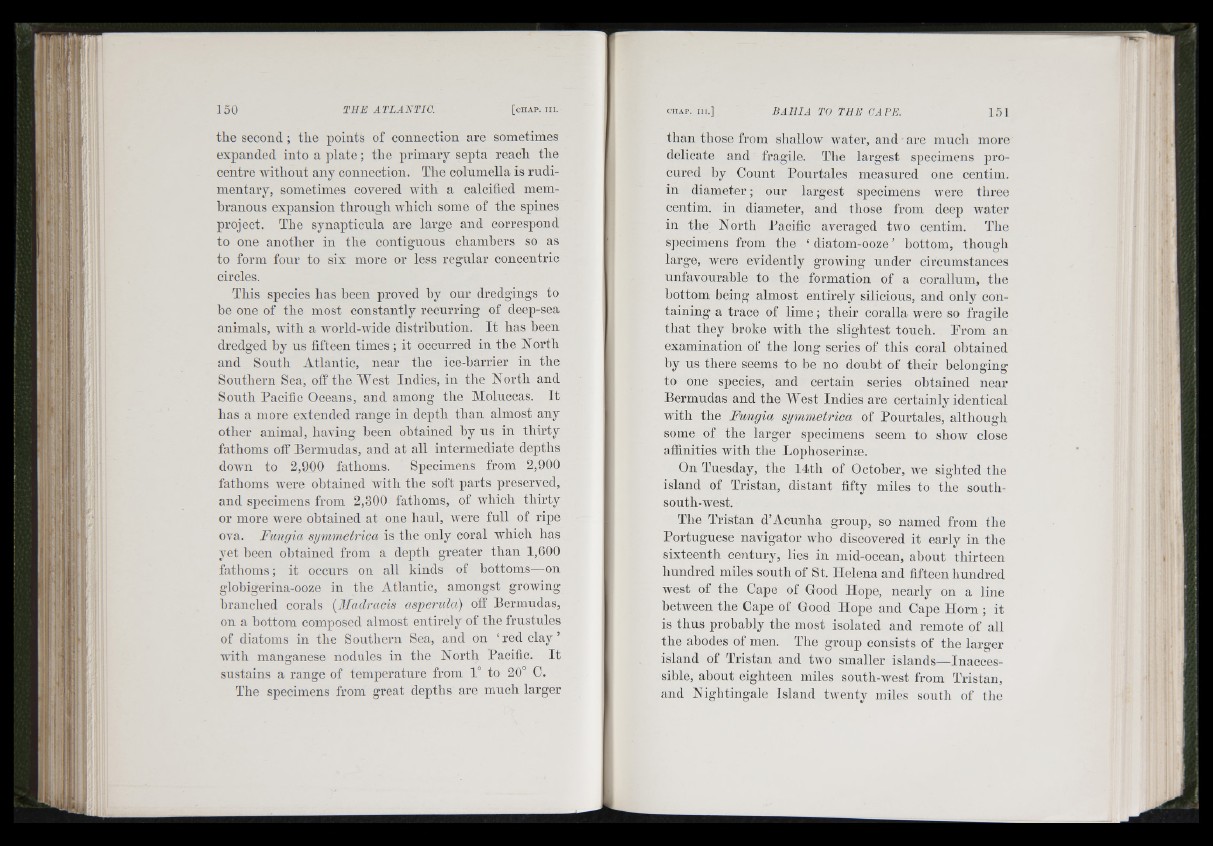
ijil
I i
:
i
1
ii
k k i !
: " i i
■i!
life ;■ I:
: 11''
r ; .
i'i
a i!
the second ; the points of connection are sometimes
expanded into a plate; the primary septa reacli the
centre without any connection. The columella is rudimentary,
sometimes covered with a calcified mem-
hranous expansion through AAdiich some of the spines
project. The synapticula are large and correspond
to one anotlier in the contiguous eliamhers so as
to form four to six more or less regular concentric
circles.
This species has heen proA'ed hy our dredgings to
he one of the most constantly recurring of deep-sea
animals, aa ith a Avorld-Avide distrihution. I t has heen
dredged hy us fifteen tim e s ; it occurred in the North
and South Atlantic, near the ice-harrier in the
Southern Sea, olf the West Indies, in the North and
South Pacific Oceans, and among the Moluccas. It
has a more extended range in depth than almost any
other animal, having heen obtained hy ns in th irty
fathoms off Bermndas, and at all intermediate depths
down to 2,900 fathoms. Specimens from 2,900
fathoms were obtained with the soft parts preserved,
and specimens from 2,300 fathoms, of AAdiich th irty
or more Avere ohtained at one haul, AA'ere full of ripe
OA'a. Fungia sijmmeUica is the only coral Avliich has
yet heen ohtained from a depth greater than 1,600
fathoms; it occurs on all kinds of hottoms—on
glohigerina-ooze in the Atlantic, amongst groAving
hranched corals [Madracis asperida) off Bermudas,
on a bottom composed almost entirely of the frustules
of diatoms in the Southern Sea, and on ‘red c la y ’
AA'ith mansjanese nodules in the North Pacific. I t
sustains a range of temperature from 1° to 20° C.
The specimens from great depths are mnch larger
than those from shalloAV Avater, and are much more
delicate and fragile. Tlie largest specimens procured
hy Count Pourtales measured one centim.
in diameter; our largest specimens AA'ere three
centim. in diameter, and those from deep water
in the North Pacific averaged tAVO centim. The
specimens from the ‘ diatom-ooze ’ hottoni, though
large, were evidently groAAing under circumstances
unfavourahle to the formation of a corallum, the
bottom being almost entirely silicions, and only containing
a trace of lim e ; their coralla were so fragile
that they broke with the slightest touch. Prom an
examination of the long series of this coral ohtained
hy us there seems to he no doubt of their belonging
to one species, and certain series obtained near
Bermudas and the MYst Indies are certainly identical
with the Fungia symmetrica of Pourtales, although
some of the larger specimens seem to show close
affinities with the Lophoserinae.
On Tuesday, the l l t l i of Octohei’, aa'c sighted the
island of Tristan, distant fifty miles to the south-
south-west.
The Tristan d’Acunha group, so named from the
Portuguese navigator aaI i o discovered it early in the
sixteenth century, lies in mid-ocean, about thirteen
Imndred miles south of St. Helena and fifteen Imndred
west of the Cape of Good Hope, nearly on a line
hetAveen the Cape of Good Hope and Cape Horn; it
is thus probably the most isolated and remote of all
the abodes of men. The group consists of the larger
island of Tristan and tAvo smaller islands—Inaccessible,
about eighteen miles soutli-Avest from Tristan,
and Nightingale Island tAventy miles south of the